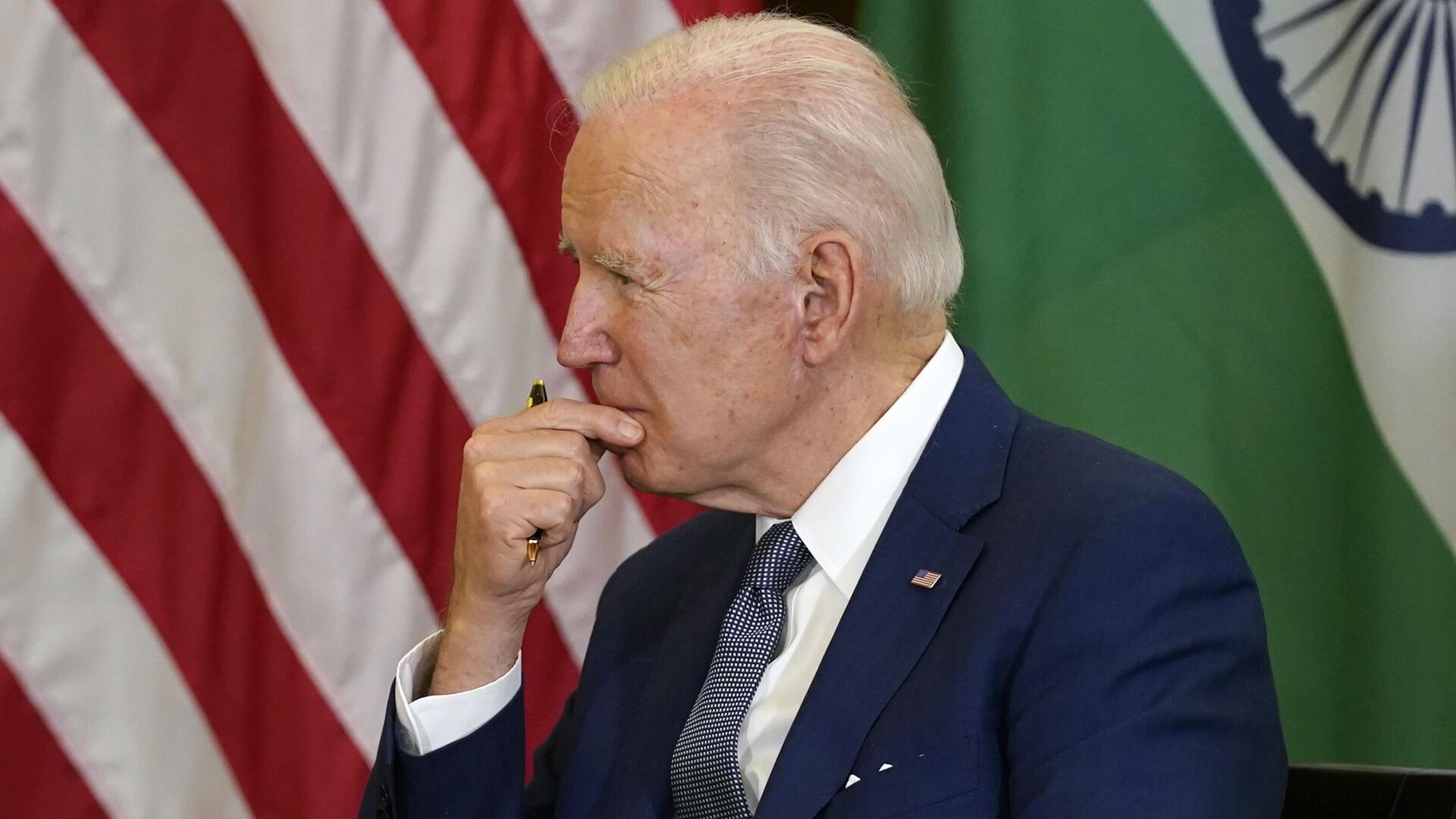https://sputniknews.in/20221213/quad-reinvented-itself-to-address-indias-sensitivities-experts-14720.html
Quad ‘Reinvented’ Itself to Address India’s ‘Sensitivities’: Experts
Quad ‘Reinvented’ Itself to Address India’s ‘Sensitivities’: Experts
Sputnik India
The Quad grouping comprising Australia, India and Japan and the US “reinvented” itself due to New Delhi’s sensitivities about being seen as part of a... 13.12.2022, Sputnik India
2022-12-13T10:00+0530
2022-12-13T10:00+0530
2022-12-22T19:09+0530
indo-pacific
joe biden
us
japan
sputnik opinion
https://cdn1.img.sputniknews.in/img/07e6/0c/0c/38613_0:157:3000:1845_1920x0_80_0_0_c17d7797e0059be851cd581948e99512.jpg
Successive US administrations have aspired to pull India away from its “position of strategic autonomy” towards a US-led security architecture directed at containing China, Talmiz Ahmad, a former Indian ambassador to Saudi Arabia and the United Arab Emirates (UAE), has told Sputnik.“That’s the reason why the Quad was revived in 2017,” Ahmad argued, referring to the relaunching of the four-nation grouping and its eventual elevation to a foreign ministerial-level meeting in 2019.The Quad was launched in 2007 but suspended in 2008 after Canberra pulled out of it over concerns expressed by China. It was revived in 2017, a year after Washington announced its "Indo-Pacific Strategy".The ex-diplomat pointed out that Beijing has always viewed the Quad as part of an “American ploy” and its elevation to a foreign ministerial level was possibly viewed as Delhi’s “abandonment of its strategic autonomy”.He said that Delhi is already on a “course correction” vis-à-vis its ties between China and the US in 2021, which led to the unveiling of the trilateral AUKUS alliance in September 2021, just days before the Quad held its first-ever summit at the White House.“It was then that the US, Australia and the UK unveiled the AUKUS pact in September 2021, but which was possibly months in the making before the formal announcement. The AUKUS was meant to replace the Quad as a new security front against China in the region,” claimed Ahmad.“In its security construct, the Quad no longer existed as of September 2021,” he stated, adding that the grouping “refashioned” itself to become a platform for cooperation on the production of COVID vaccines, supply chain resilience and climate change, among other areas.Quad Membership Serves as a ‘Reassurance’ to Regional CountriesDon McLain Gill, Director for South and Southeast Asia at the Philippine-Middle East Studies Association (PMESA), said that Delhi’s involvement in the Quad grouping serves as a “reassurance” to the other nations in the Indo-Pacific that the US-led platform won’t “indulge in bloc politics”.He said that New Delhi’s strategic autonomy is being welcomed by most of the developing nations in the Indo-Pacific at a time of heightened geopolitical tensions between Beijing and Washington.Drawing a contrast between AUKUS and the Quad, Gill said that latter was a “more flexible arrangement” and has been evolving to adjust based on the sensitivities and interests of diverse states of the region.”
indo-pacific
us
japan
Sputnik India
feedback.hindi@sputniknews.com
+74956456601
MIA „Rossiya Segodnya“
2022
Dhairya Maheshwari
https://cdn1.img.sputniknews.in/img/07e6/0c/13/138962_0:0:641:640_100x100_80_0_0_2cb44360dbcdf6d84bf4b299cd045917.jpg
Dhairya Maheshwari
https://cdn1.img.sputniknews.in/img/07e6/0c/13/138962_0:0:641:640_100x100_80_0_0_2cb44360dbcdf6d84bf4b299cd045917.jpg
News
en_IN
Sputnik India
feedback.hindi@sputniknews.com
+74956456601
MIA „Rossiya Segodnya“
Sputnik India
feedback.hindi@sputniknews.com
+74956456601
MIA „Rossiya Segodnya“
Dhairya Maheshwari
https://cdn1.img.sputniknews.in/img/07e6/0c/13/138962_0:0:641:640_100x100_80_0_0_2cb44360dbcdf6d84bf4b299cd045917.jpg
indo-pacific, joe biden, us, japan
indo-pacific, joe biden, us, japan
Quad ‘Reinvented’ Itself to Address India’s ‘Sensitivities’: Experts
10:00 13.12.2022 (Updated: 19:09 22.12.2022) The Quad grouping comprising Australia, India and Japan and the US “reinvented” itself due to New Delhi’s sensitivities about being seen as part of a Washington-led “security construct” against Beijing, argues a veteran Indian diplomat.
Successive US administrations have aspired to pull India away from its “position of strategic autonomy” towards a US-led security architecture directed at containing China, Talmiz Ahmad, a former Indian ambassador to Saudi Arabia and the United Arab Emirates (UAE), has told Sputnik.
“That’s the reason why the Quad was revived in 2017,” Ahmad argued, referring to the relaunching of the four-nation grouping and its eventual elevation to a foreign ministerial-level meeting in 2019.
The Quad was launched in 2007 but suspended in 2008 after Canberra pulled out of it over concerns expressed by China. It was revived in 2017, a year after Washington announced its "Indo-Pacific Strategy".
The ex-diplomat pointed out that Beijing has always viewed the Quad as part of an “American ploy” and its elevation to a foreign ministerial level was possibly viewed as Delhi’s “abandonment of its strategic autonomy”.
Ahmad said that the Ladakh standoff between People’s Liberation Army (PLA) and the Indian Army, which began in April-May 2020, has indicated that Delhi’s “strategic priorities” lay more at the India-China border than the South China Sea or other parts of the Pacific Ocean -- the core focal regions in Washington’s Indo-Pacific strategy. India has blamed Beijing for sparking the military standoff by transgressing at the Line of Actual Control (LAC).
He said that Delhi is already on a “course correction” vis-à-vis its ties between China and the US in 2021, which led to the unveiling of the trilateral AUKUS alliance in September 2021, just days before the Quad held its first-ever summit at the White House.
“It was then that the US, Australia and the UK unveiled the AUKUS pact in September 2021, but which was possibly months in the making before the formal announcement. The AUKUS was meant to replace the Quad as a new security front against China in the region,” claimed Ahmad.
“In its security construct, the Quad no longer existed as of September 2021,” he stated, adding that the grouping “refashioned” itself to become a platform for cooperation on the production of COVID vaccines, supply chain resilience and climate change, among other areas.
Quad Membership Serves as a ‘Reassurance’ to Regional Countries
Don McLain Gill, Director for South and Southeast Asia at the Philippine-Middle East Studies Association (PMESA), said that Delhi’s involvement in the Quad grouping serves as a “reassurance” to the other nations in the Indo-Pacific that the US-led platform won’t “indulge in bloc politics”.
“India is a rising great power, particularly in the eastern hemisphere. As it continues to rise economically and militarily, it will bring a significant level of inclusive leadership based on its adherence to democratic values and strategic autonomy,” Gill said.
He said that New Delhi’s strategic autonomy is being welcomed by most of the developing nations in the Indo-Pacific at a time of heightened geopolitical tensions between Beijing and Washington.
Drawing a contrast between AUKUS and the Quad, Gill said that latter was a “more flexible arrangement” and has been evolving to adjust based on the sensitivities and interests of diverse states of the region.”


